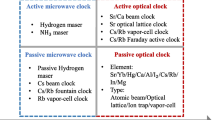Abstract
This article presents the principles and techniques of active optical clock, a special laser combining the laser physics of one-atom laser, bad-cavity gas laser, super-cavity stabilized laser and optical atomic clock together. As a simple example, an active optical clock based on thermal strontium atomic beam shows a quantum-limited linewidth of 0.51 Hz, which is insensitive to laser cavity-length noise, and may surpass the recorded narrowest 6.7 Hz of Hg ion optical clock and 1.5 Hz of very recent optical lattice clock. The estimated 0.1 Hz one-second instability and 0.27 Hz uncertainty are limited only by the relativistic Doppler effect, and can be improved by cold atoms.
Similar content being viewed by others
References
Schawlow A L, Townes C H. Infrared and optical masers. Phys Rev, 1958, 112: 1940–1949
Goldenberg M, Kleppner D, Ramsey N F. Atomic hydrogen maser. Phys Rev Lett, 1960, 5: 361–362
Gill P. Optical frequency standards. Metrologia, 2005, 42: S125–S137
Diddams S A, Bergquist J C, Jefferts S R, et al. Standards of time and frequency at the outset of the 21th century. Science, 2004, 306: 1318–1324
Takamoto M, Hong F L, Higashi R, et al. An optical lattice clock. Nature, 2005, 435: 321–324
Boyd M M, Zelevinsky T, Andrew D, et al. Optical atomic coherence at the 1-second time scale. Science, 2006, 314: 1430–1433
Riehle F. Frequency standards: Basics and applications. Weinheim: Wiley-VCH Verlag GmbH & Co. KGaA, 2004
An K, Childs J J, Dasari R R, et al. Microlaser: A laser with one atom in an optical resonator. Phys Rev Lett, 1994, 73: 3375–3378
An K, Feld M S. Semiclassical four-level single-atom laser. Phys Rev A, 1997, 56: 1662–1665
Kuppens S J M, van Exter M P, Woerdman J P. Quantum-limited linewidth of a bad-cavity laser. Phys Rev lett, 1994, 72: 3815–3818
Kolobov M I, Davidovich L, Giacobino E, et al. Role of pumping statistics and dynamics of atomic polarization in quantum fluctuations of laser sources. Phys Rev A, 1993, 47: 1431–1446
Hils D, Hall J L. Frequency Standards and Metrology. Berlin: Springer-Verlag, 1989. 162–173
Young B C, Cruz F C, Itano W M, et al. Visible lasers with Subhertz linewidths. Phys Rev Lett, 1999, 82: 3799–3802
Notcutt M, Ma L S, Ye J, et al. Simple and compact 1-Hz laser system via an improved mounting configuration of a reference cavity. Opt Lett, 2005, 30: 1815–1817
Sterr U, Degenhardt C, Stoehr H, et al. The optical calcium frequency standards of PTB and NIST. ArXiv: physics/0411094
Rafac R J, Young B C, Beall J A, et al. Sub-dekahertz ultraviolet spectroscopy of 199Hg+. Phys Rev Lett, 1999, 85: 2462–2465
Meschede D, Walther H, Mueller G. One atom maser. Phys Rev Lett 1985, 54: 551–554
Siegman A. Laser. Mill Valley CA: University Science Books, 1986
Yariv A. Quantum Electronics. 2nd ed. New York: John Wiley and Sons, 1975
Scully M O, Suessmann G, Benkert C. Quantum noise reduction via maser memory effects: Theory and applications. Phys Rev Lett, 1988, 60: 1014–1017
Ido T, Loftus T H, Boyd M M, et al. Precision spectroscopy and density-dependent frequency shifts in ultracold Sr. Phys Rev Lett, 2005, 94: 153001
An K. Semiclassical theory of the many-atom microlaser. J Korean Phy Soc, 2003, 42: 1–13
Hils D, Faller J E, Hall J L. Practical sound-reducing enclosure for laboratory use. Rev Sci Instrum, 1986, 57: 2532–2534
Scully M O, Walther H, Agarwal G S, et al. Micromaser spectrum. Phys Rev A, 1991, 44: 5992–5996
Numata K, Kemery A, Camp J. Thermal-noise limit in the frequency stabilization of lasers with rigid cavities. Phys Rev Lett, 2004, 93: 250602
Kleppner D, Berg H C, Crampton S B, et al. Hydrogen-maser principles and techniques. Phys Rev, 1965, 138: A972–A983
Courtillot I, Quessada A, Kovacich R P, et al. Efficient cooling and trapping of strontium atoms. Opt Lett, 2003, 28: 468–470
Kuppens S J M, van Exter M P, Woerdman J P, et al. Observation of the effect of spectrally inhomogeneous gain on the quantum-limited laser linewidth. Opt Commun, 1996, 126: 79–94
Magno W C, Cavasso Filho R L, Cruz F C. Two-photon Doppler cooling of alkaline-earth-metal and ytterbium atoms. Phys Rev A, 2003, 67: 043407
An K, Dasari R R, Feld M S. Traveling-wave atom cavity interaction in the single-atom microlaser. Opt Lett, 1997, 22: 1500–1502.
Chen J B, Chen X Z. Optical lattice laser. Proceedings of 2005 IEEE International Frequency Control Symposium and Exposition, 2005. 608–610
Chen J B. Active optical clock. http://arxiv.org/abs/physics/0512096
Author information
Authors and Affiliations
Corresponding author
Additional information
Supported by the National Basic Research Program of China (Grant No. 2005CB724500) and National Natural Science Foundation of China (Grant No. 10874009
About this article
Cite this article
Chen, J. Active optical clock. Chin. Sci. Bull. 54, 348–352 (2009). https://doi.org/10.1007/s11434-009-0073-y
Received:
Accepted:
Published:
Issue Date:
DOI: https://doi.org/10.1007/s11434-009-0073-y




